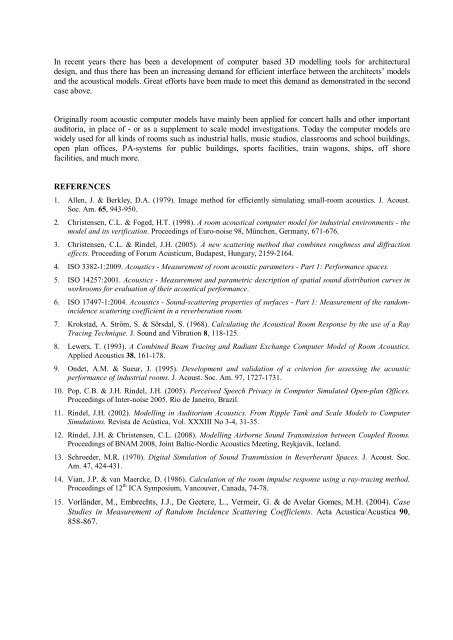ROOM ACOUSTIC PREDICTION MODELLING - Odeon
ROOM ACOUSTIC PREDICTION MODELLING - Odeon
ROOM ACOUSTIC PREDICTION MODELLING - Odeon
Create successful ePaper yourself
Turn your PDF publications into a flip-book with our unique Google optimized e-Paper software.
In recent years there has been a development of computer based 3D modelling tools for architectural<br />
design, and thus there has been an increasing demand for efficient interface between the architects’ models<br />
and the acoustical models. Great efforts have been made to meet this demand as demonstrated in the second<br />
case above.<br />
Originally room acoustic computer models have mainly been applied for concert halls and other important<br />
auditoria, in place of - or as a supplement to scale model investigations. Today the computer models are<br />
widely used for all kinds of rooms such as industrial halls, music studios, classrooms and school buildings,<br />
open plan offices, PA-systems for public buildings, sports facilities, train wagons, ships, off shore<br />
facilities, and much more.<br />
REFERENCES<br />
1. Allen, J. & Berkley, D.A. (1979). Image method for efficiently simulating small-room acoustics. J. Acoust.<br />
Soc. Am. 65, 943-950.<br />
2. Christensen, C.L. & Foged, H.T. (1998). A room acoustical computer model for industrial environments - the<br />
model and its verification. Proceedings of Euro-noise 98, München, Germany, 671-676.<br />
3. Christensen, C.L. & Rindel, J.H. (2005). A new scattering method that combines roughness and diffraction<br />
effects. Proceeding of Forum Acusticum, Budapest, Hungary, 2159-2164.<br />
4. ISO 3382-1:2009. Acoustics - Measurement of room acoustic parameters - Part 1: Performance spaces.<br />
5. ISO 14257:2001. Acoustics - Measurement and parametric description of spatial sound distribution curves in<br />
workrooms for evaluation of their acoustical performance.<br />
6. ISO 17497-1:2004. Acoustics - Sound-scattering properties of surfaces - Part 1: Measurement of the randomincidence<br />
scattering coefficient in a reverberation room.<br />
7. Krokstad, A. Ström, S. & Sörsdal, S. (1968). Calculating the Acoustical Room Response by the use of a Ray<br />
Tracing Technique. J. Sound and Vibration 8, 118-125.<br />
8. Lewers, T. (1993). A Combined Beam Tracing and Radiant Exchange Computer Model of Room Acoustics.<br />
Applied Acoustics 38, 161-178.<br />
9. Ondet, A.M. & Sueur, J. (1995). Development and validation of a criterion for assessing the acoustic<br />
performance of industrial rooms. J. Acoust. Soc. Am. 97, 1727-1731.<br />
10. Pop, C.B. & J.H. Rindel, J.H. (2005). Perceived Speech Privacy in Computer Simulated Open-plan Offices.<br />
Proceedings of Inter-noise 2005. Rio de Janeiro, Brazil.<br />
11. Rindel, J.H. (2002). Modelling in Auditorium Acoustics. From Ripple Tank and Scale Models to Computer<br />
Simulations. Revista de Acústica, Vol. XXXIII No 3-4, 31-35.<br />
12. Rindel, J.H. & Christensen, C.L. (2008). Modelling Airborne Sound Transmission between Coupled Rooms.<br />
Proceedings of BNAM 2008, Joint Baltic-Nordic Acoustics Meeting, Reykjavik, Iceland.<br />
13. Schroeder, M.R. (1970). Digital Simulation of Sound Transmission in Reverberant Spaces. J. Acoust. Soc.<br />
Am. 47, 424-431.<br />
14. Vian, J.P. & van Maercke, D. (1986). Calculation of the room impulse response using a ray-tracing method.<br />
Proceedings of 12 th ICA Symposium, Vancouver, Canada, 74-78.<br />
15. Vorländer, M., Embrechts, J.J., De Geetere, L., Vermeir, G. & de Avelar Gomes, M.H. (2004). Case<br />
Studies in Measurement of Random Incidence Scattering Coefficients. Acta Acustica/Acustica 90,<br />
858-867.

















